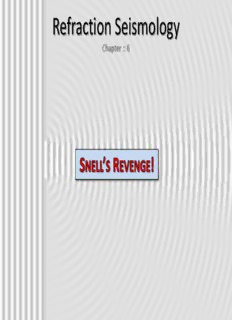
Refraction Seismology - Appalachian State University PDF
Preview Refraction Seismology - Appalachian State University
Refraction Seismology Chapter :: 6 Snell’s Law & Critical Refraction sin i sin i 1 2 v v 1 2 • Because seismic sources radiate waves in all directions • Some ray must hit interface at exactly the critical angle, i c • This critically oriented ray will then travel along the interface between the two layers sin i sin 90 c • If more oblique than critical, all v v 1 2 wave energy is reflected v – The reflected energy is useful too! sin i 1 c v • E.g. Chapter 7 2 v i arcsin 1 c v 2 Critical Refraction and Wave Fronts • When a ray meets a new layer at the critical angle… • The ray travels along the interface • What layer is it in? • Rays, aren’t real, so consider the wave fronts… • Wave fronts travel in both layers • Wave front in top continues on the same trajectory • Wave front in Bottom has to be perpendicular to the ray • But the layers have different velocities • This sets up wavelets and head waves… Huygens’s Principle • Recall that rays are not real – They are just an easy way to understand and quantify waves • Wave fronts are what is really happening – But what causes wave fronts? • Huygens’s wavelets explains… – Each point along a material is acts like a point source of waves – Like a pebble dropped into water Huygens’s Wavelets • Huygens (a 17th century Dutch physicist) realized that: – When any particle oscillates it is a tiny source of waves • So, every point on a wave front acts as a small source that generates waves • The waves have circular (spherical) wave fronts and are called wavelets • Wavelets constructively interact (reinforcement) to produce the wave front – Has important implications for diffraction and critical refraction Final Wave Front New Wave Front Wavelets Trough Planar wave front Wavelets and Diffraction • If wavelets didn’t occur, we wouldn’t be able to hear around corners. – Light doesn’t travel around corners very well because of its very high frequency If only there were wavelets… then I could hear you What Up Dr. Kate?? Wavelets and Diffraction • Because of wavelets, a wave front that encounters an obstacle: – Will travel through the open space – The wave front after the barrier diffracts, or bends into an area that is predicted to be a shadow by ray theory. • But what about critical refraction?? (java animation) Final Wave Front Wasuuuup! New Wave Front Wavelets What Up Dr. Kate?? Wavelets and Head Waves • The wave front just above the interface produces a continual stream of critically refracted rays • The wave front just below the interface does the same • These stream of critically refracted rays form wavelets • The wavelets combine to form head waves – The head waves propagate up to the surface and can be recorded. • The recorded rays are called the refracted rays Potential Paths in a Refraction Survey • When doing a seismic refraction survey, a recorded ray can come from three main paths – The direct ray – The reflected ray – The refracted ray • Because these rays travel different distances and at different speeds, they arrive at different times • The direct ray and the refracted ray arrive in different order depending on distance from source and the velocity structure Receiver Shot Point (i.e. the Source) Direct Ray i i c c v 1 Layer 1 Layer 2 v 2 The Time-Distance (t-x) Diagram Think about: • What would a fast velocity look like on this plot? • Why is direct ray a straight line? • Why must the direct ray plot start at the origin (0,0)? • Why is refracted ray straight line? • Why does refracted ray not start at origin? • Why does reflected ray start at origin? • Why is reflected ray asymptotic with direct ray?
Description: